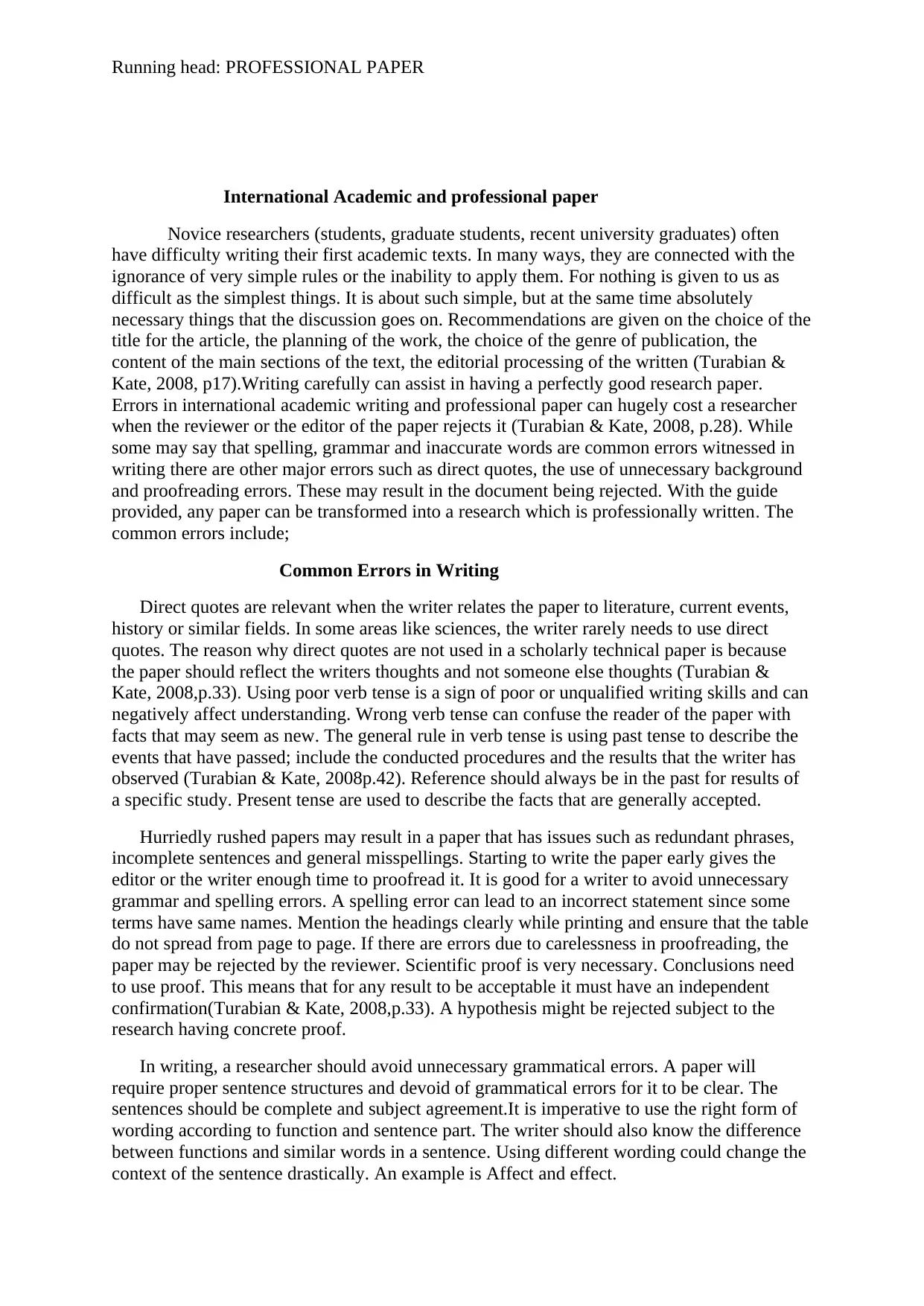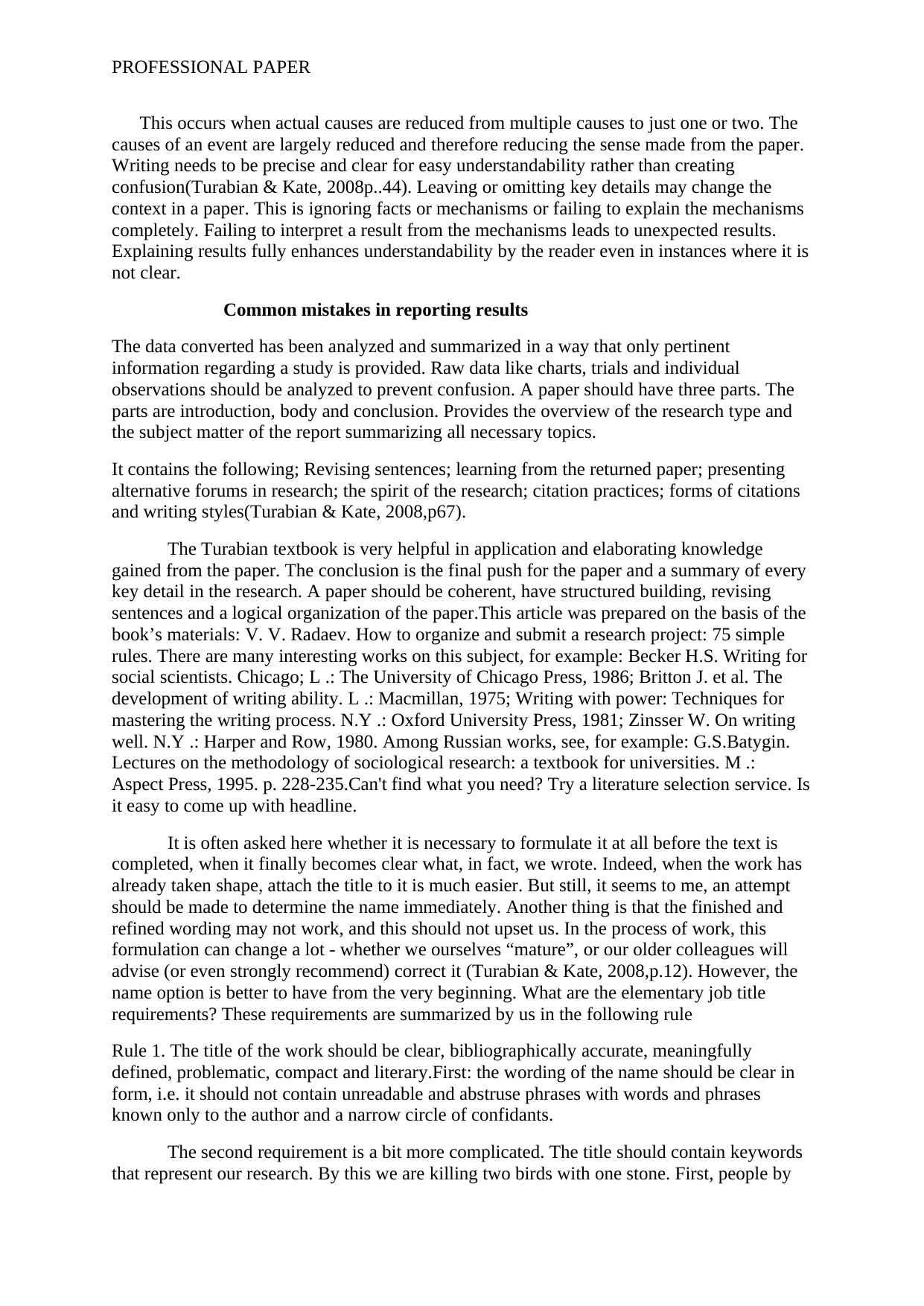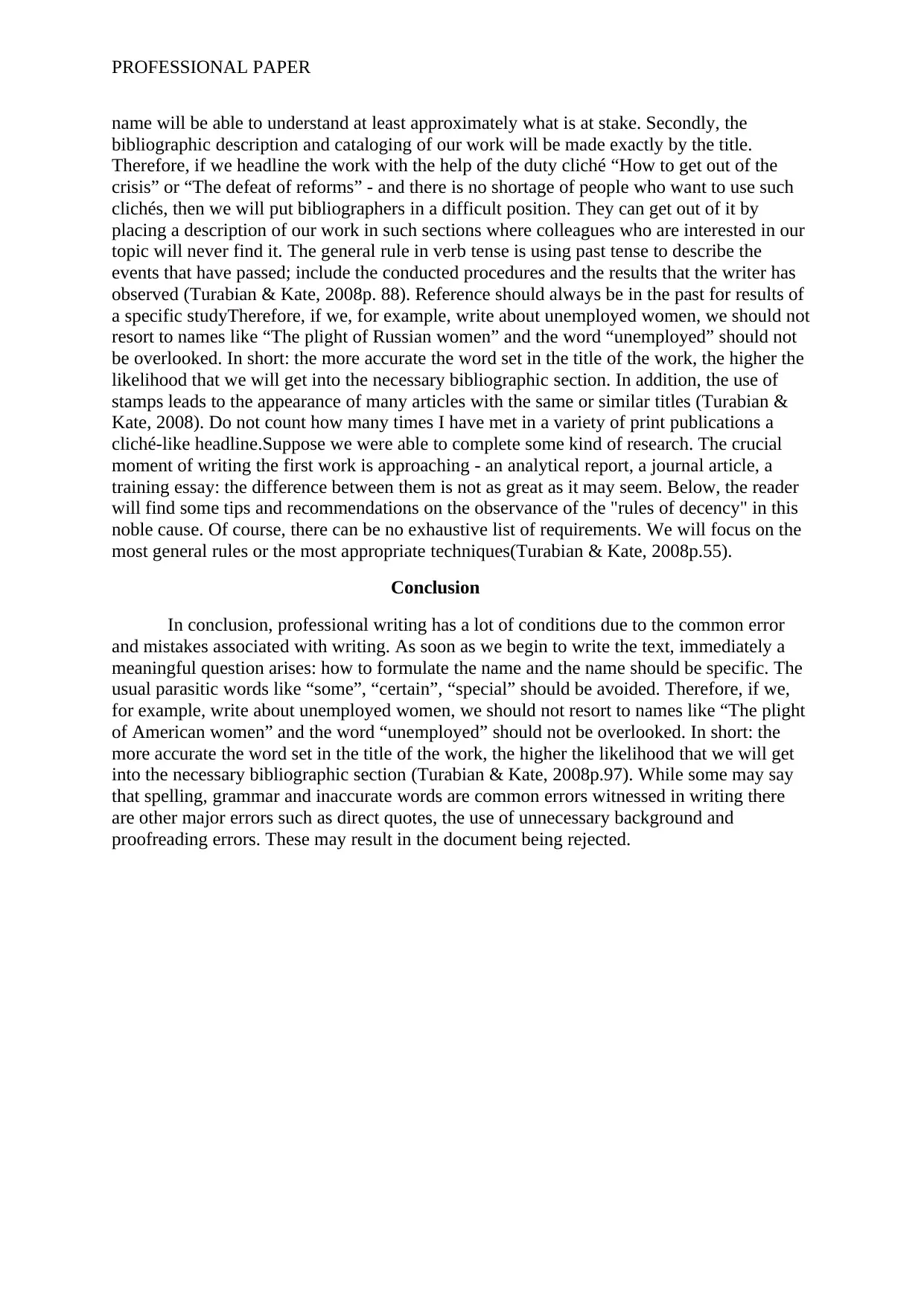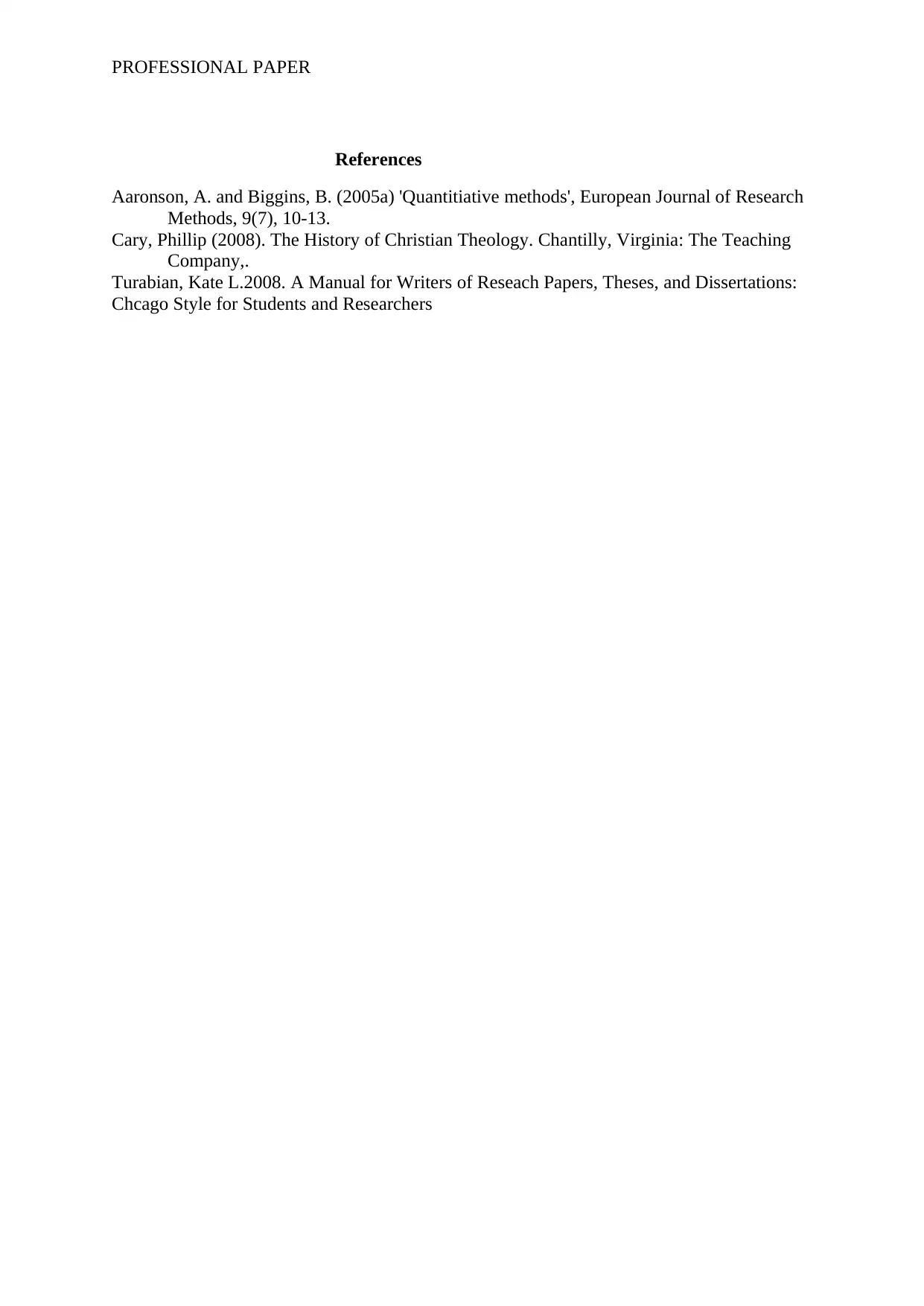A Comprehensive Guide to Avoiding Common Errors in Professional Papers
VerifiedAdded on 2022/11/19
|4
|2055
|417
Report
AI Summary
This report provides a detailed analysis of common errors in academic and professional papers, drawing upon the provided text and assignment brief. The report identifies frequent mistakes such as the misuse of direct quotes, incorrect verb tense, proofreading oversights, irrelevant information, grammatical and spelling errors, inaccurate word choices, oversimplification, and superficiality. It emphasizes the importance of precise writing, proper sentence structure, and clear presentation of results. The report also includes practical advice on structuring research papers, selecting appropriate titles, and adhering to citation guidelines. The content is structured in a way that helps novice researchers, including students and recent graduates, to improve the quality of their writing and avoid common pitfalls that can lead to paper rejection. The report also highlights the importance of proofreading and using scientific proof to support conclusions. The provided materials, including references to Turabian's manual, offer practical guidance on how to structure and present research effectively. This information is particularly relevant for professional development in the field of academic writing and research.

Running head: PROFESSIONAL PAPER
International Academic and professional paper
Novice researchers (students, graduate students, recent university graduates) often
have difficulty writing their first academic texts. In many ways, they are connected with the
ignorance of very simple rules or the inability to apply them. For nothing is given to us as
difficult as the simplest things. It is about such simple, but at the same time absolutely
necessary things that the discussion goes on. Recommendations are given on the choice of the
title for the article, the planning of the work, the choice of the genre of publication, the
content of the main sections of the text, the editorial processing of the written (Turabian &
Kate, 2008, p17).Writing carefully can assist in having a perfectly good research paper.
Errors in international academic writing and professional paper can hugely cost a researcher
when the reviewer or the editor of the paper rejects it (Turabian & Kate, 2008, p.28). While
some may say that spelling, grammar and inaccurate words are common errors witnessed in
writing there are other major errors such as direct quotes, the use of unnecessary background
and proofreading errors. These may result in the document being rejected. With the guide
provided, any paper can be transformed into a research which is professionally written. The
common errors include;
Common Errors in Writing
Direct quotes are relevant when the writer relates the paper to literature, current events,
history or similar fields. In some areas like sciences, the writer rarely needs to use direct
quotes. The reason why direct quotes are not used in a scholarly technical paper is because
the paper should reflect the writers thoughts and not someone else thoughts (Turabian &
Kate, 2008,p.33). Using poor verb tense is a sign of poor or unqualified writing skills and can
negatively affect understanding. Wrong verb tense can confuse the reader of the paper with
facts that may seem as new. The general rule in verb tense is using past tense to describe the
events that have passed; include the conducted procedures and the results that the writer has
observed (Turabian & Kate, 2008p.42). Reference should always be in the past for results of
a specific study. Present tense are used to describe the facts that are generally accepted.
Hurriedly rushed papers may result in a paper that has issues such as redundant phrases,
incomplete sentences and general misspellings. Starting to write the paper early gives the
editor or the writer enough time to proofread it. It is good for a writer to avoid unnecessary
grammar and spelling errors. A spelling error can lead to an incorrect statement since some
terms have same names. Mention the headings clearly while printing and ensure that the table
do not spread from page to page. If there are errors due to carelessness in proofreading, the
paper may be rejected by the reviewer. Scientific proof is very necessary. Conclusions need
to use proof. This means that for any result to be acceptable it must have an independent
confirmation(Turabian & Kate, 2008,p.33). A hypothesis might be rejected subject to the
research having concrete proof.
In writing, a researcher should avoid unnecessary grammatical errors. A paper will
require proper sentence structures and devoid of grammatical errors for it to be clear. The
sentences should be complete and subject agreement.It is imperative to use the right form of
wording according to function and sentence part. The writer should also know the difference
between functions and similar words in a sentence. Using different wording could change the
context of the sentence drastically. An example is Affect and effect.
International Academic and professional paper
Novice researchers (students, graduate students, recent university graduates) often
have difficulty writing their first academic texts. In many ways, they are connected with the
ignorance of very simple rules or the inability to apply them. For nothing is given to us as
difficult as the simplest things. It is about such simple, but at the same time absolutely
necessary things that the discussion goes on. Recommendations are given on the choice of the
title for the article, the planning of the work, the choice of the genre of publication, the
content of the main sections of the text, the editorial processing of the written (Turabian &
Kate, 2008, p17).Writing carefully can assist in having a perfectly good research paper.
Errors in international academic writing and professional paper can hugely cost a researcher
when the reviewer or the editor of the paper rejects it (Turabian & Kate, 2008, p.28). While
some may say that spelling, grammar and inaccurate words are common errors witnessed in
writing there are other major errors such as direct quotes, the use of unnecessary background
and proofreading errors. These may result in the document being rejected. With the guide
provided, any paper can be transformed into a research which is professionally written. The
common errors include;
Common Errors in Writing
Direct quotes are relevant when the writer relates the paper to literature, current events,
history or similar fields. In some areas like sciences, the writer rarely needs to use direct
quotes. The reason why direct quotes are not used in a scholarly technical paper is because
the paper should reflect the writers thoughts and not someone else thoughts (Turabian &
Kate, 2008,p.33). Using poor verb tense is a sign of poor or unqualified writing skills and can
negatively affect understanding. Wrong verb tense can confuse the reader of the paper with
facts that may seem as new. The general rule in verb tense is using past tense to describe the
events that have passed; include the conducted procedures and the results that the writer has
observed (Turabian & Kate, 2008p.42). Reference should always be in the past for results of
a specific study. Present tense are used to describe the facts that are generally accepted.
Hurriedly rushed papers may result in a paper that has issues such as redundant phrases,
incomplete sentences and general misspellings. Starting to write the paper early gives the
editor or the writer enough time to proofread it. It is good for a writer to avoid unnecessary
grammar and spelling errors. A spelling error can lead to an incorrect statement since some
terms have same names. Mention the headings clearly while printing and ensure that the table
do not spread from page to page. If there are errors due to carelessness in proofreading, the
paper may be rejected by the reviewer. Scientific proof is very necessary. Conclusions need
to use proof. This means that for any result to be acceptable it must have an independent
confirmation(Turabian & Kate, 2008,p.33). A hypothesis might be rejected subject to the
research having concrete proof.
In writing, a researcher should avoid unnecessary grammatical errors. A paper will
require proper sentence structures and devoid of grammatical errors for it to be clear. The
sentences should be complete and subject agreement.It is imperative to use the right form of
wording according to function and sentence part. The writer should also know the difference
between functions and similar words in a sentence. Using different wording could change the
context of the sentence drastically. An example is Affect and effect.
Paraphrase This Document
Need a fresh take? Get an instant paraphrase of this document with our AI Paraphraser

PROFESSIONAL PAPER
This occurs when actual causes are reduced from multiple causes to just one or two. The
causes of an event are largely reduced and therefore reducing the sense made from the paper.
Writing needs to be precise and clear for easy understandability rather than creating
confusion(Turabian & Kate, 2008p..44). Leaving or omitting key details may change the
context in a paper. This is ignoring facts or mechanisms or failing to explain the mechanisms
completely. Failing to interpret a result from the mechanisms leads to unexpected results.
Explaining results fully enhances understandability by the reader even in instances where it is
not clear.
Common mistakes in reporting results
The data converted has been analyzed and summarized in a way that only pertinent
information regarding a study is provided. Raw data like charts, trials and individual
observations should be analyzed to prevent confusion. A paper should have three parts. The
parts are introduction, body and conclusion. Provides the overview of the research type and
the subject matter of the report summarizing all necessary topics.
It contains the following; Revising sentences; learning from the returned paper; presenting
alternative forums in research; the spirit of the research; citation practices; forms of citations
and writing styles(Turabian & Kate, 2008,p67).
The Turabian textbook is very helpful in application and elaborating knowledge
gained from the paper. The conclusion is the final push for the paper and a summary of every
key detail in the research. A paper should be coherent, have structured building, revising
sentences and a logical organization of the paper.This article was prepared on the basis of the
book’s materials: V. V. Radaev. How to organize and submit a research project: 75 simple
rules. There are many interesting works on this subject, for example: Becker H.S. Writing for
social scientists. Chicago; L .: The University of Chicago Press, 1986; Britton J. et al. The
development of writing ability. L .: Macmillan, 1975; Writing with power: Techniques for
mastering the writing process. N.Y .: Oxford University Press, 1981; Zinsser W. On writing
well. N.Y .: Harper and Row, 1980. Among Russian works, see, for example: G.S.Batygin.
Lectures on the methodology of sociological research: a textbook for universities. M .:
Aspect Press, 1995. p. 228-235.Can't find what you need? Try a literature selection service. Is
it easy to come up with headline.
It is often asked here whether it is necessary to formulate it at all before the text is
completed, when it finally becomes clear what, in fact, we wrote. Indeed, when the work has
already taken shape, attach the title to it is much easier. But still, it seems to me, an attempt
should be made to determine the name immediately. Another thing is that the finished and
refined wording may not work, and this should not upset us. In the process of work, this
formulation can change a lot - whether we ourselves “mature”, or our older colleagues will
advise (or even strongly recommend) correct it (Turabian & Kate, 2008,p.12). However, the
name option is better to have from the very beginning. What are the elementary job title
requirements? These requirements are summarized by us in the following rule
Rule 1. The title of the work should be clear, bibliographically accurate, meaningfully
defined, problematic, compact and literary.First: the wording of the name should be clear in
form, i.e. it should not contain unreadable and abstruse phrases with words and phrases
known only to the author and a narrow circle of confidants.
The second requirement is a bit more complicated. The title should contain keywords
that represent our research. By this we are killing two birds with one stone. First, people by
This occurs when actual causes are reduced from multiple causes to just one or two. The
causes of an event are largely reduced and therefore reducing the sense made from the paper.
Writing needs to be precise and clear for easy understandability rather than creating
confusion(Turabian & Kate, 2008p..44). Leaving or omitting key details may change the
context in a paper. This is ignoring facts or mechanisms or failing to explain the mechanisms
completely. Failing to interpret a result from the mechanisms leads to unexpected results.
Explaining results fully enhances understandability by the reader even in instances where it is
not clear.
Common mistakes in reporting results
The data converted has been analyzed and summarized in a way that only pertinent
information regarding a study is provided. Raw data like charts, trials and individual
observations should be analyzed to prevent confusion. A paper should have three parts. The
parts are introduction, body and conclusion. Provides the overview of the research type and
the subject matter of the report summarizing all necessary topics.
It contains the following; Revising sentences; learning from the returned paper; presenting
alternative forums in research; the spirit of the research; citation practices; forms of citations
and writing styles(Turabian & Kate, 2008,p67).
The Turabian textbook is very helpful in application and elaborating knowledge
gained from the paper. The conclusion is the final push for the paper and a summary of every
key detail in the research. A paper should be coherent, have structured building, revising
sentences and a logical organization of the paper.This article was prepared on the basis of the
book’s materials: V. V. Radaev. How to organize and submit a research project: 75 simple
rules. There are many interesting works on this subject, for example: Becker H.S. Writing for
social scientists. Chicago; L .: The University of Chicago Press, 1986; Britton J. et al. The
development of writing ability. L .: Macmillan, 1975; Writing with power: Techniques for
mastering the writing process. N.Y .: Oxford University Press, 1981; Zinsser W. On writing
well. N.Y .: Harper and Row, 1980. Among Russian works, see, for example: G.S.Batygin.
Lectures on the methodology of sociological research: a textbook for universities. M .:
Aspect Press, 1995. p. 228-235.Can't find what you need? Try a literature selection service. Is
it easy to come up with headline.
It is often asked here whether it is necessary to formulate it at all before the text is
completed, when it finally becomes clear what, in fact, we wrote. Indeed, when the work has
already taken shape, attach the title to it is much easier. But still, it seems to me, an attempt
should be made to determine the name immediately. Another thing is that the finished and
refined wording may not work, and this should not upset us. In the process of work, this
formulation can change a lot - whether we ourselves “mature”, or our older colleagues will
advise (or even strongly recommend) correct it (Turabian & Kate, 2008,p.12). However, the
name option is better to have from the very beginning. What are the elementary job title
requirements? These requirements are summarized by us in the following rule
Rule 1. The title of the work should be clear, bibliographically accurate, meaningfully
defined, problematic, compact and literary.First: the wording of the name should be clear in
form, i.e. it should not contain unreadable and abstruse phrases with words and phrases
known only to the author and a narrow circle of confidants.
The second requirement is a bit more complicated. The title should contain keywords
that represent our research. By this we are killing two birds with one stone. First, people by

PROFESSIONAL PAPER
name will be able to understand at least approximately what is at stake. Secondly, the
bibliographic description and cataloging of our work will be made exactly by the title.
Therefore, if we headline the work with the help of the duty cliché “How to get out of the
crisis” or “The defeat of reforms” - and there is no shortage of people who want to use such
clichés, then we will put bibliographers in a difficult position. They can get out of it by
placing a description of our work in such sections where colleagues who are interested in our
topic will never find it. The general rule in verb tense is using past tense to describe the
events that have passed; include the conducted procedures and the results that the writer has
observed (Turabian & Kate, 2008p. 88). Reference should always be in the past for results of
a specific studyTherefore, if we, for example, write about unemployed women, we should not
resort to names like “The plight of Russian women” and the word “unemployed” should not
be overlooked. In short: the more accurate the word set in the title of the work, the higher the
likelihood that we will get into the necessary bibliographic section. In addition, the use of
stamps leads to the appearance of many articles with the same or similar titles (Turabian &
Kate, 2008). Do not count how many times I have met in a variety of print publications a
cliché-like headline.Suppose we were able to complete some kind of research. The crucial
moment of writing the first work is approaching - an analytical report, a journal article, a
training essay: the difference between them is not as great as it may seem. Below, the reader
will find some tips and recommendations on the observance of the "rules of decency" in this
noble cause. Of course, there can be no exhaustive list of requirements. We will focus on the
most general rules or the most appropriate techniques(Turabian & Kate, 2008p.55).
Conclusion
In conclusion, professional writing has a lot of conditions due to the common error
and mistakes associated with writing. As soon as we begin to write the text, immediately a
meaningful question arises: how to formulate the name and the name should be specific. The
usual parasitic words like “some”, “certain”, “special” should be avoided. Therefore, if we,
for example, write about unemployed women, we should not resort to names like “The plight
of American women” and the word “unemployed” should not be overlooked. In short: the
more accurate the word set in the title of the work, the higher the likelihood that we will get
into the necessary bibliographic section (Turabian & Kate, 2008p.97). While some may say
that spelling, grammar and inaccurate words are common errors witnessed in writing there
are other major errors such as direct quotes, the use of unnecessary background and
proofreading errors. These may result in the document being rejected.
name will be able to understand at least approximately what is at stake. Secondly, the
bibliographic description and cataloging of our work will be made exactly by the title.
Therefore, if we headline the work with the help of the duty cliché “How to get out of the
crisis” or “The defeat of reforms” - and there is no shortage of people who want to use such
clichés, then we will put bibliographers in a difficult position. They can get out of it by
placing a description of our work in such sections where colleagues who are interested in our
topic will never find it. The general rule in verb tense is using past tense to describe the
events that have passed; include the conducted procedures and the results that the writer has
observed (Turabian & Kate, 2008p. 88). Reference should always be in the past for results of
a specific studyTherefore, if we, for example, write about unemployed women, we should not
resort to names like “The plight of Russian women” and the word “unemployed” should not
be overlooked. In short: the more accurate the word set in the title of the work, the higher the
likelihood that we will get into the necessary bibliographic section. In addition, the use of
stamps leads to the appearance of many articles with the same or similar titles (Turabian &
Kate, 2008). Do not count how many times I have met in a variety of print publications a
cliché-like headline.Suppose we were able to complete some kind of research. The crucial
moment of writing the first work is approaching - an analytical report, a journal article, a
training essay: the difference between them is not as great as it may seem. Below, the reader
will find some tips and recommendations on the observance of the "rules of decency" in this
noble cause. Of course, there can be no exhaustive list of requirements. We will focus on the
most general rules or the most appropriate techniques(Turabian & Kate, 2008p.55).
Conclusion
In conclusion, professional writing has a lot of conditions due to the common error
and mistakes associated with writing. As soon as we begin to write the text, immediately a
meaningful question arises: how to formulate the name and the name should be specific. The
usual parasitic words like “some”, “certain”, “special” should be avoided. Therefore, if we,
for example, write about unemployed women, we should not resort to names like “The plight
of American women” and the word “unemployed” should not be overlooked. In short: the
more accurate the word set in the title of the work, the higher the likelihood that we will get
into the necessary bibliographic section (Turabian & Kate, 2008p.97). While some may say
that spelling, grammar and inaccurate words are common errors witnessed in writing there
are other major errors such as direct quotes, the use of unnecessary background and
proofreading errors. These may result in the document being rejected.
⊘ This is a preview!⊘
Do you want full access?
Subscribe today to unlock all pages.

Trusted by 1+ million students worldwide

PROFESSIONAL PAPER
References
Aaronson, A. and Biggins, B. (2005a) 'Quantitiative methods', European Journal of Research
Methods, 9(7), 10-13.
Cary, Phillip (2008). The History of Christian Theology. Chantilly, Virginia: The Teaching
Company,.
Turabian, Kate L.2008. A Manual for Writers of Reseach Papers, Theses, and Dissertations:
Chcago Style for Students and Researchers
References
Aaronson, A. and Biggins, B. (2005a) 'Quantitiative methods', European Journal of Research
Methods, 9(7), 10-13.
Cary, Phillip (2008). The History of Christian Theology. Chantilly, Virginia: The Teaching
Company,.
Turabian, Kate L.2008. A Manual for Writers of Reseach Papers, Theses, and Dissertations:
Chcago Style for Students and Researchers
1 out of 4
Your All-in-One AI-Powered Toolkit for Academic Success.
+13062052269
info@desklib.com
Available 24*7 on WhatsApp / Email
![[object Object]](/_next/static/media/star-bottom.7253800d.svg)
Unlock your academic potential
Copyright © 2020–2025 A2Z Services. All Rights Reserved. Developed and managed by ZUCOL.